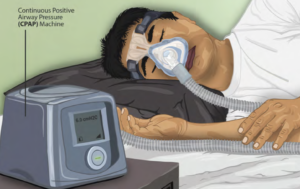Continuous Positive Airway Pressure (CPAP)

A continuous positive airway pressure (CPAP) device is used for people who are able to breathe spontaneously on their own but need help in keeping their airway unobstructed, such as those with obstructive sleep apnea.
The CPAP device consists of a special mask that covers the client’s nose, or nose and mouth, and is attached to a machine that continuously applies mild air pressure to keep the client’s airways from collapsing.
A prescription is required for a CPAP device in the hospital or client’s home environment. In the hospital, the FiO2 is set up with the CPAP mask by the respiratory therapist. In a home setting, an adapter is added so that oxygen is attached using a flowmeter with preprogrammed settings so the client/nurse and/or Health Care Assistant are only required to turn the machine on before sleeping and off upon awakening. It is important to keep the mask and tubing clean to prevent infection, so be sure to follow agency policy for cleaning the equipment regularly. If a humidifier is attached, distilled water or sterile water should be used to fill it, but never tap water. See Figure 9.4.1 for an illustration of a patient wearing a CPAP device while sleeping.
Bilevel Positive Airway Pressure (BiPAP)
A Bilevel Positive Airway Pressure (BiPAP) device is similar to a CPAP device in that it is used to prevent airways from collapsing, but BiPAP devices have two pressure settings. One setting occurs during inhalation and a lower pressure setting is used during exhalation. Clients using BiPAP devices in their home environment for obstructive sleep apnea often find these two pressures more tolerable because they don’t have to exhale against continuous pressure. In acute-care settings, BiPAP devices are also used for clients in acute respiratory distress as a noninvasive alternative to intubation and mechanical ventilation and are managed by respiratory therapists. BiPAP devices in home settings are set up in a similar manner as CPAP machines for ease of use.
Watch this YouTube video on how to use a CPAP machine

